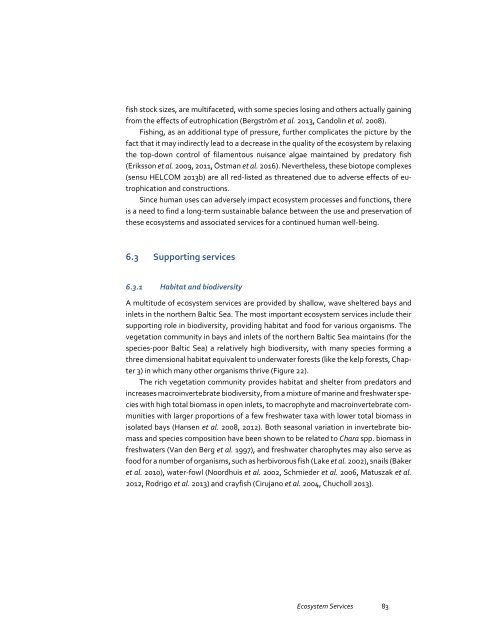Ecosystem Services
FULLTEXT01
FULLTEXT01
You also want an ePaper? Increase the reach of your titles
YUMPU automatically turns print PDFs into web optimized ePapers that Google loves.
fish stock sizes, are multifaceted, with some species losing and others actually gaining<br />
from the effects of eutrophication (Bergström et al. 2013, Candolin et al. 2008).<br />
Fishing, as an additional type of pressure, further complicates the picture by the<br />
fact that it may indirectly lead to a decrease in the quality of the ecosystem by relaxing<br />
the top-down control of filamentous nuisance algae maintained by predatory fish<br />
(Eriksson et al. 2009, 2011, Östman et al. 2016). Nevertheless, these biotope complexes<br />
(sensu HELCOM 2013b) are all red-listed as threatened due to adverse effects of eutrophication<br />
and constructions.<br />
Since human uses can adversely impact ecosystem processes and functions, there<br />
is a need to find a long-term sustainable balance between the use and preservation of<br />
these ecosystems and associated services for a continued human well-being.<br />
6.3 Supporting services<br />
6.3.1 Habitat and biodiversity<br />
A multitude of ecosystem services are provided by shallow, wave sheltered bays and<br />
inlets in the northern Baltic Sea. The most important ecosystem services include their<br />
supporting role in biodiversity, providing habitat and food for various organisms. The<br />
vegetation community in bays and inlets of the northern Baltic Sea maintains (for the<br />
species-poor Baltic Sea) a relatively high biodiversity, with many species forming a<br />
three dimensional habitat equivalent to underwater forests (like the kelp forests, Chapter<br />
3) in which many other organisms thrive (Figure 22).<br />
The rich vegetation community provides habitat and shelter from predators and<br />
increases macroinvertebrate biodiversity, from a mixture of marine and freshwater species<br />
with high total biomass in open inlets, to macrophyte and macroinvertebrate communities<br />
with larger proportions of a few freshwater taxa with lower total biomass in<br />
isolated bays (Hansen et al. 2008, 2012). Both seasonal variation in invertebrate biomass<br />
and species composition have been shown to be related to Chara spp. biomass in<br />
freshwaters (Van den Berg et al. 1997), and freshwater charophytes may also serve as<br />
food for a number of organisms, such as herbivorous fish (Lake et al. 2002), snails (Baker<br />
et al. 2010), water-fowl (Noordhuis et al. 2002, Schmieder et al. 2006, Matuszak et al.<br />
2012, Rodrigo et al. 2013) and crayfish (Cirujano et al. 2004, Chucholl 2013).<br />
<strong>Ecosystem</strong> <strong>Services</strong> 83


